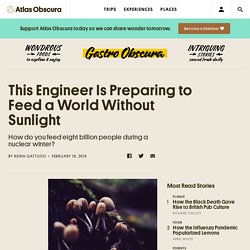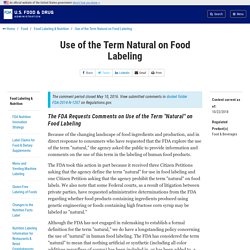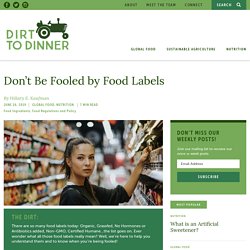

This Engineer Is Preparing to Feed a World Without Sunlight. David Denkenberger wants to build a system to feed eight billion people in a world without sunlight.

His inspiration: the humble mushroom. In 2011, Denkenberger was reading a scientific paper that suggested that after such a catastrophe, humans would die out, while mushrooms would thrive in the dark. According to Denkenberger, his reaction was, “Well, why don’t we just eat the mushrooms and not go extinct?” A sunless future is more possible than you might think. The Bulletin of the Atomic Scientists calls the world’s current risk of nuclear war “urgent.” To make this preparation a reality, Denkenberger, an engineer and assistant professor at the University of Alaska, Fairbanks, co-founded the Alliance to Feed the Earth in Disasters (ALLFED). Some of the needed technologies already exist.
Technology alone won’t save us if society breaks down and violence reigns. Why Are People Suddenly Saying That Whole Grains Are Bad for Your Gut? Starter Culture - an overview. Introduction and History Starter cultures are an essential component of nearly all commercially produced fermented foods.

Simply defined, starter cultures consist of microorganisms that are inoculated directly into food materials in order to bring about desired and predictable changes in the finished product. These changes may include enhanced preservation, improved nutritional value, modified sensory qualities, and increased economic value. Although many fermented foods can be made without a starter culture, the addition of concentrated microorganisms, in the form of a starter culture, provides a basis for insuring that products are manufactured on a consistent schedule, with consistent product qualities. Are There Hormones in Milk? The Dirt: Are there hormones in milk?

Yes! All milk contains naturally-occurring hormones. Sour Milk: Lessons from Scandinavia - Nourished Kitchen. Yemoos Nourishing Cultures. • Fresh pasteurized milk.

Avoid lactose-free, raw*, cream on the top, dried milk powder or alternative milks for activation. Whole, pasteurized milk is best to begin with (you can switch later). Skim or low fat milk will work, but the filmjölk flora prefer the full range of nutrition found in whole milk. The texture is better, as well. You can always compromise by switching to whole milk (or adding some heavy whipping cream) every once in awhile, if you prefer a lower fat milk for yourself. *Raw milk has natural bacteria that can overwhelm the can overwhelm the Filmjölk - especially when activating. 1. When you are ready to start making Filmjölk, place (approx 1 teaspoon) of the dried Filmjölk into a small, clean jar. Feed the dried Filmjölk, 1/4 cup (4 tablespoons) of milk (see section above on what milk to use). Organic Cultures - Fil Mjölk Yogurt Starter Instructions Finished Fil Mjolk Dairy Culture Make your own fresh farmer type cultured cheese with Fil Dairy Starter.
How to make crusty bread - Flourish - King Arthur Flour. 50 Percent Whole-Wheat Sourdough Bread. The Biology of . . . Sourdough. About 34 years ago, Frank Sugihara recalls, he and Leo Kline, a fellow microbiologist, set out to "solve the mystery of San Francisco sourdough.

" The two scientists were working with baker's yeast in a Bay Area lab run by the U.S. Department of Agriculture, so perhaps it was inevitable they'd wind up studying San Francisco's signature bread. Sourdough Science. How to Convert Your Recipe to Metric and Use Weights Instead of Volume. Use of the Term Natural on Food Labeling. The FDA Requests Comments on Use of the Term "Natural" on Food Labeling Because of the changing landscape of food ingredients and production, and in direct response to consumers who have requested that the FDA explore the use of the term "natural," the agency asked the public to provide information and comments on the use of this term in the labeling of human food products.

The FDA took this action in part because it received three Citizen Petitions asking that the agency define the term "natural" for use in food labeling and one Citizen Petition asking that the agency prohibit the term "natural" on food labels. We also note that some Federal courts, as a result of litigation between private parties, have requested administrative determinations from the FDA regarding whether food products containing ingredients produced using genetic engineering or foods containing high fructose corn syrup may be labeled as "natural. " Don’t Be Fooled by Food Labels - Dirt To Dinner.
The Dirt: There are so many food labels today: Organic, Grassfed, No Hormones or Antibiotics added, Non-GMO, Certified Humane…the list goes on.

Ever wonder what all those food labels really mean? Well, we’re here to help you understand them and to know when you’re being fooled! Here I am at Costco, getting far too many things for my household of four. As I try to navigate my unwieldy cart around, I see a new product – avocado oil. Meat and Poultry Labeling Terms. What does 'mechanically separated meat or poultry' mean?

" What Meat Labels Like 'Organic' and 'Grass Fed' Actually Mean—and Whether You Should Care - Certified Humane. ... en vue. The Beautiful World of Microscopic Food. How the food you eat affects your gut - Shilpa Ravella. Organica. Rousing. Invigorating. *joi de vivre. Vitality. Robust. Nourishment. VICTUALS. Nutrition.